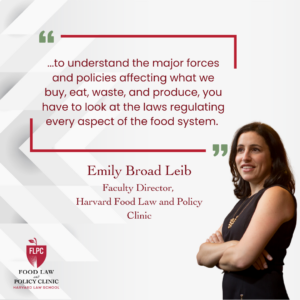This post was written by Samantha Goerger, Policy Fellow for ReFED.
Policy is a critical lever for accelerating the adoption of food waste reduction solutions at a large scale – and 2021 was a watershed year for food waste policy at all levels of government. A range of policies were proposed to help support efforts across the food system to cut the amount of food lost or wasted each year, and a surprisingly large number of these were actually enacted – especially on the state and local levels, where the most forward movement is occurring.
To help make sense of the policy landscape, ReFED has updated and relaunched the Food Waste Policy Finder, an online resource developed and maintained in partnership with the Harvard Law School Food Law and Policy Clinic (FLPC), which allows users to explore legislative and regulatory policy at the federal, state, and local levels. The Policy Finder is part of ReFED’s Insights Engine, a comprehensive resource for food waste data and solutions to help all sectors of the food system take action against loss and waste.
“Having worked on legislation and policy around food waste for over a decade, I am energized by the momentum we saw in the 2021 legislative season,” said Emily Broad Leib, Clinical Professor of Law and Director of Harvard Law School’s Food Law and Policy Clinic. “From waste bans to additional funding, so many states are making big moves to address the issue of food waste, improve food access, and create resilient and strong food systems.”
“Policy is unique in its power to provide a spark that can move the food system to action. That’s why we’re excited to see so much movement on policies that have the potential to drive significant reductions in food waste,” said Dana Gunders, Executive Director of ReFED. “Not all of the policies that were proposed were actually enacted, but the fact that food waste is part of the conversation is an important step forward. We’re looking forward to seeing what 2022 will bring.”
To help educate policymakers on the most effective food waste reduction policies, ReFED and FLPC worked with NRDC and WWF to develop the Food Waste Action Plan, which offered five policy action areas where the government is uniquely positioned to make an impact:
- Invest in Prevention and Keep Waste Out of Landfills
- Enable Surplus Food Donation
- Show U.S. Leadership at Home and Abroad
- Educate and Activate Consumers
- Standardize National Date Labeling
Here’s a look at the legislation proposed and enacted in 2021 according to the Policy Finder:
FEDERAL
The U.S. Congress is considering several pieces of legislation that would advance key aspects of the Food Waste Action Plan. In addition to the Zero Food Waste Act and COMPOST Act which were introduced last summer, bipartisan congressional coalitions have introduced several bills that would address food loss and waste. Here, we highlight three bills that would standardize date labeling, expand food donation liability protections, and fund school projects for reducing food waste.
The Food Date Labeling Act would require food products to have standard date labels, and would require federal agencies to create a consumer education campaign to address misconceptions. “Best if Used By” would be used on products labeled to indicate quality, while “Use By” would instead be used on a select number of products to indicate the date after which there may be safety concerns. It has been shown that standardizing date labeling can save 582,000 tons of food annually. Lack of standardization leads to consumer confusion. 84% of people report sometimes or always throwing out past-date food, even though this food may be perfectly good to eat. By standardizing labels, consumers – and businesses – may be taught that foods past the peak quality date are still safe to consume.
The Food Donation Improvement Act would enhance the landmark Bill Emerson Good Samaritan Act by expanding donation liability protections for food donors and food recovery organizations. Enhancing food recovery efforts is essential to halving food waste by 2030, but many food businesses avoid donating for fear of liability. Strengthening food rescue through liability protections and donation education can save 1.1 million tons of food annually. This bill would require the USDA to clarify the Emerson Act and promote awareness of the Act. Additionally, the Emerson Act would be expanded to include donations made directly from food businesses to persons in need and donations that are ultimately sold for a nominal fee. Direct donations allow businesses to donate small quantities of food that do not meet the quantity threshold for donation pickup, and by charging a nominal fee nonprofits can cover the costs of transporting and storing food donations.
The School Food Recovery Act would provide grants for food waste prevention and reduction projects. Addressing food waste at schools provides a unique opportunity to save school funds, tackle a large source of landfilled waste, and educate future consumers on the importance of preventing food waste. The School Food Recovery Act is one of many recent bills that recognize this important intersection. For example, another bill, US H 4802 would modify the Richard B. Russell National School Lunch Act by clarifying that charitable organizations may accept food donations from schools.
We are excited to see Congress emphasizing prevention and recovery efforts, and we look forward to watching these bills progress.
STATES
State legislatures introduced 99 bills related to food waste in 2021 – 28 of which passed. The top three categories for introduced legislation in 2021 were waste bans, research programs, and funding. At least five bills were passed in each of the following categories: donation programs, waste bans, and funding. School food waste programs, consumer awareness, and composting clarifications also saw many successes with at least three bills enacted. While 25 different states introduced food waste legislation, California, Maryland, and New Jersey led states with three enacted bills, followed closely by New York and West Virginia with two each. Some highlights of the enacted laws include two new waste bans (MD, NJ), funding approval in five states (CA, MA, MN, NY, and WA), and expanded donation liability protections in two states (HI, RI). Additionally, the governors of New Jersey and Connecticut issued executive orders which expand the definition of “green job” to include food waste reduction and require state agencies to divert food waste, respectively. As we look back on the 2021 policy successes, we would like to spotlight some innovative policies that may spark further success in 2022.
Connecticut expanded their waste ban law via legislation with CT H 6503. The threshold for commercial food waste generators subject to the law was reduced from 52 tons/year to 26 tons/year starting January 1, 2022, but businesses are still exempt if they are located more than 20 miles from an authorized recycling facility. Additionally, Governor Ned Lamont issued executive order CT 31, which requires all “executive branch agency facilities,” to divert organics and food waste from the landfill. Because government agencies employ large portions of the population and generate a sizable amount of waste, adding waste reduction and diversion requirements to these agencies is an easy, highly impactful step that state governments can take to reduce the volume of landfilled organic waste.
New York built on their 2019 Food Donation and Food Scraps Recycling Law with NY S 901 which requires that large groceries stores donate their “excess edible food” to qualified “food relief organizations,” such as religious or nonprofit organizations. The law mandates that stores “from time to time make excess edible food available,” though it does not require that they transport or distribute the excess food themselves. Hopefully this law will aid in the development of food recovery relationships that are sustained.
Funding is essential to implementing food waste programs, and this was acknowledged by five states that explicitly budgeted for food waste prevention, recovery, or recycling: CA, MA, MN, NY, and WA. For example, Minnesota passed MN S 20 which grants $1.63 million to comprehensive food waste efforts, $1 million of which is directed higher in the EPA Food Recovery Hierarchy to waste prevention and recovery. Washington established a general waste reduction fund, 60% of which is allocated to waste reduction, recycling, and composting activities. While not exclusively funding food loss and waste programs, this funding creates avenues to expand waste diversion efforts and to incorporate programs higher up the food waste hierarchy.
Three states focused waste reduction and food recovery efforts on schools. Illinois and New Hampshire created food sharing plans, which instruct schools to preserve leftover food and send it home with students or donate it to local food banks. Rhode Island passed an innovative, comprehensive law that addresses food waste at the source with mandatory waste audits every three years at all public and private schools. Rhode Island school food vendors are now required to donate leftover food to local recovery organizations, and liability protections were expanded to explicitly cover these donations, including past-date items from any donor. The law also reduces the waste ban threshold for public and private schools from 52 tons per year to 30 tons per year beginning in January 2023.
While individual bills help in the fight against food waste, food systems are complex and require a comprehensive outlook to ensure lasting change. New Jersey and Maryland took steps towards systemic change by creating the Office of the Food Insecurity Advocate and the Food System Resiliency Council, respectively – both of which aim to address food insecurity through a range of measures, with explicit reference to food waste reduction and food recovery.
Download a comprehensive list of state and federal bills introduced in 2021 here.


Health Law & Policy, Commentary
Braidwood Management v. Becerra: Updated FAQs for Health Advocates and Providers
July 22, 2024